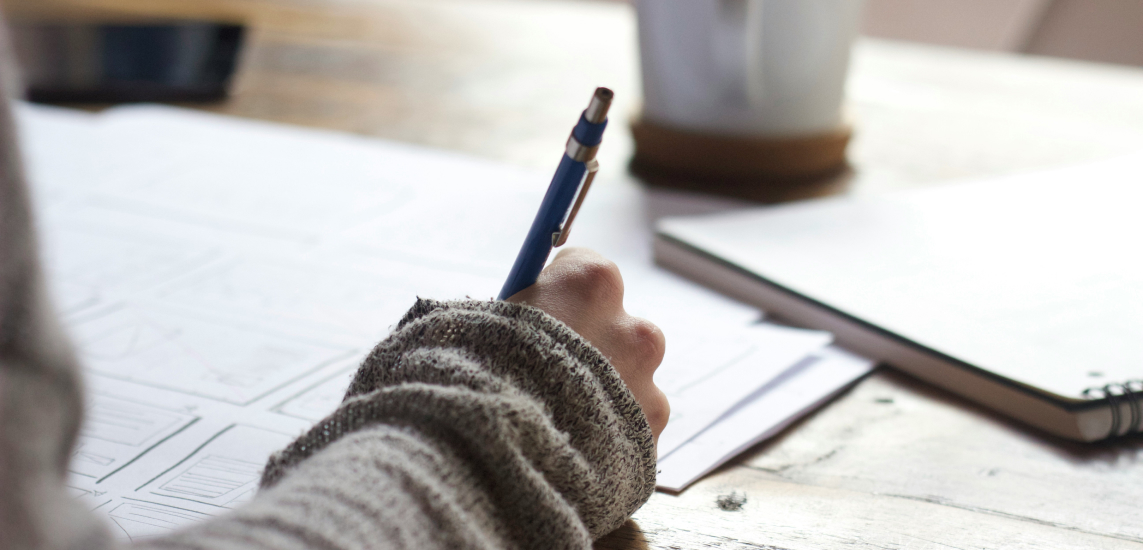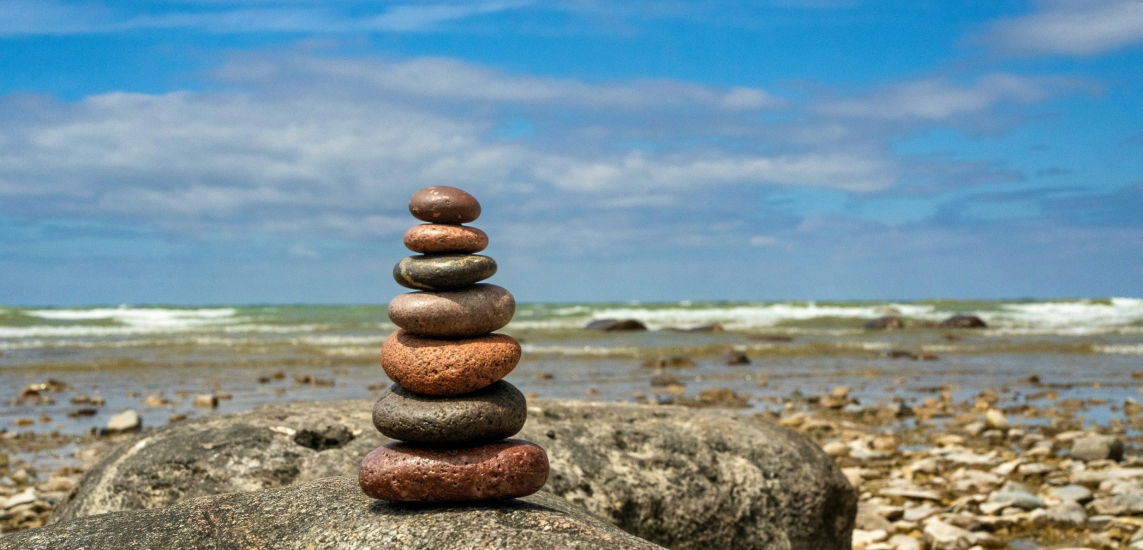This article was created using personal insights from Insight Timer’s meditation teachers.
Imagine you’re in the middle of a chaotic workday, juggling multiple tasks and feeling your stress levels rise. You take a moment to breathe deeply, feel the chair beneath you, and notice the sounds around you. This simple act brings you back to the present moment, easing your anxiety and restoring your focus.
Mindfulness grounding techniques are powerful tools that help anchor us in the present, combat stress, and help us feel calm. In this article, we’ll explore mindfulness grounding techniques, how they work, and provide you with ten practical techniques to incorporate into your daily life.
Key takeaways:
- Mindfulness grounding techniques can help you reconnect with the present moment by shifting focus away from stressors.
- Simple practices like deep breathing, body scans, progressive muscle relaxation, and sensory awareness can be easily integrated into the workday to promote calm and clarity.
- The benefits of mindful grounding include reduced anxiety, enhanced emotional regulation, physical relaxation, and much more.
- Insight Timer makes it easy to develop an effective grounding practice with over 200,000 free guided meditations to support your routine.
Unsure where to begin? Insight Timer’s therapist-created mindfulness worksheets and resources are designed to support present-moment awareness and grounding.
What is mindfulness grounding and how does it work?
Grounding mindfully involves any practice designed to connect us with the present moment by engaging our senses and focusing on our immediate surroundings. These approaches have roots in ancient meditation and mindfulness practices, but they’ve been adapted and refined over time to suit modern needs.
Eszter Farkas, an Insight Timer meditation teacher, describes these types of grounding as “practices that help bring our attention back to the present and reunite our minds and bodies during stressful times.”
Grounding techniques work by deliberately shifting our focus from stressors or overwhelming thoughts to our external environment to something tangible and present. We make this shift by engaging our senses, such as feeling the texture of an object, listening to soothing sounds, or observing our breathing.
Lai Tattis, also an Insight Timer meditation teacher, explains that “grounding can be done anytime and anywhere, as the main aim is to keep your mind and body connected.” When we redirect our attention to the present moment, our brain’s stress response decreases, leading to reduced anxiety and improved mental clarity.
Benefits of grounding techniques include:
- Immediate anxiety relief
- Enhanced focus and concentration
- Improved emotional regulation
- Increased mental clarity
10 grounding practices to combat work-related stress
Several grounding techniques support greater mindfulness, connection, and calm. Here are the top ten for managing stress and painful emotions at work.
1. Deep breathing exercises
Deep breathing is a simple yet powerful grounding technique. Focusing on your breath can slow down your heart rate and calm your mind. The steps for deep breathing, a variation of “box breathing”, are:
- Sit comfortably and close your eyes.
- Inhale deeply through your nose for a count of four.
- Hold your breath for a count of four.
- Exhale slowly through your mouth for a count of six. Repeat this cycle several times until you feel more relaxed.
Lynn Fraser, an Insight Timer meditation teacher, emphasizes the importance of smooth continuous diaphragmatic breathing to release stress and bring us into the present moment. It is also an easy practice for managing an anxiety spiral or soothing a panic attack.
Breathe deeper and fuller with an ujjayi deep breathing practice.
2. Progressive muscle relaxation
Progressive muscle relaxation involves tensing and then slowly releasing different muscle groups. This technique helps reduce physical tension and promote relaxation.
Start with your toes and work your way up to your head, tensing each muscle group for 5-10 seconds, then releasing and relaxing for 20-30 seconds before moving to the next group. This method is particularly effective after a long day at work.
3. Body scan meditation
A body scan meditation helps you tune into physical sensations and release tension. It also helps you feel more connected to your body and less overwhelmed by stress. To practice:
- Lie down or sit comfortably.
- Close your eyes and take a few deep breaths.
- Slowly scan your body from head to toe, noticing any areas of tension or discomfort.
- As you become aware of these areas, breathe into them and imagine the tension melting away.
Lai Tattis shares,
“. . .clients often notice a significant shift in their ability to stay present and reduce emotional distress through regular body scan meditations.”
4. The 5-4-3-2-1 method
This grounding exercise uses your five senses to bring you back to the present moment. The 5-4-3-2-1 method takes you through each sense as you identify:
- 5 things you can see.
- 4 things you can touch.
- 3 things you can hear.
- 2 things you can smell.
- 1 thing you can taste.
By engaging your five senses, this method helps your mind shift away from feeling wound up. By slowing down managing anxiety becomes easier.
Learn how to tap into your senses quickly and effectively with a deeper look at the 5-4-3-2-1 grounding exercise.
5. Mindful walking
Mindful walking involves paying close attention to the physical act of walking and the earth beneath you.
Find a quiet place to walk slowly, focusing on the sensation of your feet touching the ground, the movement of your legs, and the rhythm of your breath. If your mind begins to wander, gently bring it back to the act of walking. This technique is perfect during a lunch break or after a long meeting.
Eszter Farkas shares that taking a mindful walk along the River Danube helps her clear her mind, connect with her body, and feel a profound sense of freedom and stability.
6. Visualization
Visualization meditation is one of the mental grounding techniques and involves imagining a peaceful and calming place. Follow these steps for visualization:
- Sit or lie down comfortably and close your eyes.
- Picture a place where you feel safe and relaxed, such as a beach, forest, or meadow.
- Engage all your senses to make the visualization as vivid as possible.
- Spend some time in this imagined place, soaking in the tranquility.
Visualization can help you quickly reduce stress and anxiety.
7. Sensory grounding
Sensory grounding engages all your senses to stop an anxiety attack. Some ways to engage your senses are:
- Hold a textured object, such as a rock or a piece of fabric, and focus on how it feels.
- Listen to calming music or nature sounds and notice each note.
- Smell a soothing scent, such as lavender or eucalyptus.
Lynn Fraser suggests,
“Look around the room for cues of safety helps our nervous system know we are here in the present, not in the past.”
By concentrating on sensory experiences, you distract yourself, soothe the amped-up physical responses of stress, and regain a sense of calm.
8. Journaling
Writing down your thoughts and feelings can be a powerful way to ground yourself. Set aside a few minutes each day to write in a journal, describing your current feelings, what’s on your mind, and any sources of stress.
Reflect on what you wrote and consider any patterns or insights. Journaling can help you process emotions and gain perspective on stressful situations.
9. Exercise
Physical exercises are an excellent way to ground yourself and release pent-up stress. Engage in a form of exercise you enjoy, such as running, yoga, or dancing. Focus on the movement of your body and the sensation of your muscles working. Allow yourself to fully immerse in how your body feels.
Regular exercise can improve your overall mood and resilience to stress. Lynn Fraser highlights that walking on the beach or in the forest brings her back to the present and helps her enjoy life more fully.
10. Grounding through touch
Using touch to ground yourself can be very effective. Here are a few different strategies:
- Place your hands under running water and focus on the sensation and the water’s temperature.
- Hold an ice cube and concentrate on the cold feeling as it melts.
- Press your feet firmly into the ground and notice the support from the earth.
These simple actions can quickly bring your attention back to the present moment.
Eszter Farkas shares her experience.
“It’s impressive how quickly and tangibly these techniques can pull us out of overwhelmed states, bringing about moments of calm and centeredness.”
When should you use mindful grounding techniques?
Mindful grounding techniques can be used anytime you experience anxiety or feel overwhelmed or disconnected. Below, we’ll explore when to use grounding techniques in more detail.
During a panic attack
Grounding techniques can be incredibly helpful during panic attacks. By focusing on the present moment, you can reduce rapid breathing and the intensity of the panic and regain control.
A grounding technique like the 5-4-3-2-1 method or breathing exercises like deep breathing provide immediate relief and help you stay anchored. Practicing grounding regularly can also help reduce the frequency and severity of panic attacks over time.
Before a high-stakes work meeting
Using grounding exercises before an important meeting can help calm your nerves and improve your focus. Techniques such as deep breathing or visualization can be particularly effective in these situations.
Taking a few moments to ground yourself can enhance your confidence and performance during the meeting. This can be especially useful before presentations, negotiations, or other high-pressure work situations.
Experiencing elevated anxiety
When you notice your anxiety levels rising and your mind seeking safety, anxiety grounding techniques can provide immediate relief. Practices like the 5-4-3-2-1 method or sensory grounding quickly shift your focus away from anxious thoughts.
Regular use of grounding techniques can help you manage anxiety more effectively and prevent it from escalating. Lai Tattis emphasizes,
“Grounding exercises promote positive feelings, making negative emotions less overwhelming and helping clients regain their inner peace and balance.”
After a long workday
After a stressful day at work, grounding techniques can help you unwind and transition into a more relaxed state. Grounding exercises can help you let go of work-related stress, allowing you to enjoy your personal time more fully. Incorporating these practices into your evening routine can also promote better sleep and overall well-being.
Eszter Farkas shares that holding an object like a smooth stone and focusing on its coolness can help her feel grounded and present.
Integrating grounding techniques into your professional life
Start your day with grounding exercises
Incorporate grounding exercises into your morning routine to start the day with a clear mind and set a calm and focused tone for the day. This can improve your overall productivity and reduce stress throughout the day.
Beginning your day with grounding exercises can also help you approach your tasks with a positive and balanced mindset.
Try morning meditation. Set the tone for a more aware and mindful day with this helpful guided morning meditation by Fleur Chambers.
Take grounding breaks
Throughout your workday, take short breaks to practice grounding techniques. Whether it’s a quick walk, a couple of minutes of deep breathing, or holding a textured object, these breaks can help you stay centered and reduce stress.
Regular grounding breaks can even enhance your focus and prevent burnout. Lynn Fraser suggests starting with what you enjoy and building resilience and strength from there.
Use grounding techniques before important tasks
Before tackling a challenging task or project, use a grounding exercise to calm your mind and improve concentration. Visualization or sensory grounding can be particularly helpful in these moments.
End your workday with grounding
As you transition from work to personal time, use grounding techniques to unwind and release any residual stress. Physical grounding techniques like a body scan meditation or progressive muscle relaxation can help you leave work-related stress behind.
Ending your workday with grounding practices can improve your work-life balance and overall well-being. Establishing a grounding routine at the end of your day can also help you mentally and emotionally prepare for the next day.
Explore our guided sleep meditations to improve rest, recovery, and sleep quality.
The science behind mindfulness grounding techniques
Mindfulness grounding techniques are supported by scientific research that highlights their benefits. Here are some scientifically backed benefits.
Reduces anxiety and stress
Grounding techniques lower the body’s stress response by engaging the parasympathetic nervous system — the rest and digest system.
These techniques include mindful breathing, body scanning, and yoga. Research shows how they can stimulate the vagus nerve and boost parasympathetic activity. This activation helps reduce stress reactions and promotes a sense of calm. According to additional studies, grounding techniques, like earthing mats, can reduce stress. They do this by modulating the corticotropin process, reducing tension and anxiety, and boosting energy.
Improves focus and concentration
Shifting focus to the present moment enhances mental clarity and cognitive function.
Studies have shown that mindfulness grounding techniques can significantly enhance focus and concentration. Mindfulness promotes attention to the present. It helps with:
- emotion regulation
- focus
- cognitive ability
Mindfulness is about practicing open awareness and observation without judgment. It helps people connect with the present moment. Research indicates that this connection fosters increased mental clarity and enhances cognitive function. By using mindfulness grounding techniques daily, individuals can improve focus and well-being.
Enhances emotional regulation
Regular practice of grounding techniques helps regulate emotions and improves overall emotional resilience.
Mindfulness grounding practices, such as cognitive restructuring and meditation, have been shown to help enhance coping abilities and emotional control. They can also increase a person’s positive feelings. Grounding techniques like mindfulness and distress tolerance also help. According to work in Frontiers in Psychology, these practices lead to improved emotional resilience over time. They help people face life’s challenges more smoothly and confidently.
Promotes physical relaxation
Techniques like progressive muscle relaxation can reduce muscle tension and promote physical relaxation.
These techniques reduce muscle tension and create a deep calm and repose. Studies show that progressive muscle relaxation can lower catecholamine levels, inhibiting the sympathetic nervous system and activating the parasympathetic nervous system. Also, researchers have found that rhythmic breathing, combined with muscle relaxation, can:
- relieve muscle spasms
- reduce pain
- improve relaxation
Build a simple and effective grounding practice with Insight Timer
Insight Timer’s mindfulness and meditation app can help you develop a simple yet effective grounding practice. With over 200,000 free guided meditations, including mindful grounding practices, you have access to a wealth of resources to support your practice. Join our structured courses for extra support and benefit from thousands of expert-led sessions.
Top meditation teachers from around the world are here to guide you. Visit Insight Timer to explore more.
Mindfulness grounding techniques FAQs
Can grounding techniques replace other forms of stress management or therapy?
Grounding techniques are a valuable tool for managing stress, but they are not a replacement for professional therapy or other stress management methods. They can complement other strategies to create a comprehensive approach to mental well-being.
How quickly can I expect to see results from using these grounding techniques?
The effectiveness of grounding techniques can vary from person to person. Some people may feel immediate relief, while others may need to practice regularly to notice significant changes. Consistency is key.
How do I know which grounding technique is best for me?
Experiment with different grounding techniques to see which ones resonate with you. Pay attention to how each practice makes you feel and choose the ones that provide the most relief and comfort.
Can I use grounding techniques while at work?
Yes, many grounding techniques can be easily incorporated into your workday. Techniques such as deep breathing, sensory grounding, and mindful walking can be practiced during breaks or even at your desk.
Are there any risks associated with grounding techniques?
Grounding techniques are generally safe for most people. However, if you have a history of trauma or certain mental health conditions, some techniques may trigger uncomfortable feelings. If this happens, consult with a mental health professional.
How often should I practice grounding techniques?
To gain the most benefit, try to incorporate grounding techniques into your daily routine. Even a few minutes each day can make a significant difference in managing stress and improving mental well-being.
By integrating these mindfulness grounding techniques into your professional life, you can build resilience, reduce stress, and maintain a calm, focused mind in any situation.
References
Agnieszka Chojak. “Recent Findings in the Pathogenesis and Treatment of Fear and Anxiety.” Neuropsychiatria I Neuropsychologia, vol. 17, no. 3-4, 1 Jan. 2022, pp. 132–139, https://doi.org/10.5114/nan.2022.124690. Accessed 13 Dec. 2023.
Agustin, Yuliana, et al. “Giving Warm Compresses with Progressive Muscle Relaxation Techniques Can Reduce Pain Intensity in Dysmenorrhea.” Journal of Complementary Nursing, vol. 1, no. 3, 1 Oct. 2022, pp. 99–105, https://doi.org/10.53801/jcn.v1i3.51.
Duncan, Larissa G., et al. “A Model of Mindful Parenting: Implications for Parent–Child Relationships and Prevention Research.” Clinical Child and Family Psychology Review, vol. 12, no. 3, 2 May 2009, pp. 255–270, https://doi.org/10.1007/s10567-009-0046-3.
Fassbinder, Eva, et al. “Emotion Regulation in Schema Therapy and Dialectical Behavior Therapy.” Frontiers in Psychology, vol. 7, no. 1373, 14 Sept. 2016, www.ncbi.nlm.nih.gov/pmc/articles/PMC5021701, https://doi.org/10.3389/fpsyg.2016.01373.
Izgu, Nur, et al. “Progressive Muscle Relaxation and Mindfulness Meditation on Neuropathic Pain, Fatigue, and Quality of Life in Patients with Type 2 Diabetes: A Randomized Clinical Trial.” Journal of Nursing Scholarship, 13 June 2020, https://doi.org/10.1111/jnu.12580.
Jabeen, Shazia, et al. “Exploring the Relationship between Emotional Intelligence and Resilience: A Clinical Psychological Perspective.” Bulletin of Business and Economics, vol. 13, no. 1, 25 Mar. 2024, https://doi.org/10.61506/01.00215. Accessed 17 June 2024.
Park, Hyun-Jung , et al. “The Effect of Earthing Mat on Stress-Induced Anxiety-like Behavior and Neuroendocrine Changes in the Rat.” ProQuest, vol. 11, no. 1, 2023, p. 57, www.proquest.com/docview/2767184534?accountid=13858&parentSessionId=5UbbhsLuXh%2FkEBwEr5g7n2394iVrZZyrqRXKAmztUv8%3D&pq-origsite=primo, https://doi.org/10.3390/biomedicines11010057.
Primdahl, Nis L. “Becoming “Intimate” with the Present Moment: Mindfulness and the Question of Temporality.” Time & Society, 25 Sept. 2022, p. 0961463X2211233, https://doi.org/10.1177/0961463×221123356. Accessed 16 Nov. 2022.







